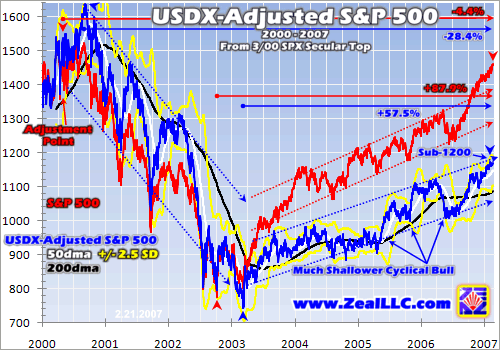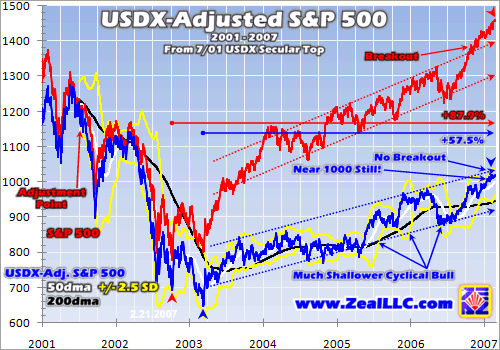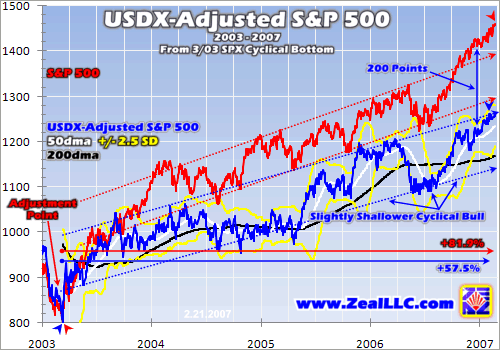|
|
|||||||
|
|
|
|
|
|
|
|
|
|
Dollar-Adjusted S&P 500 Adam Hamilton February 23, 2007 2680 Words
As a markets junkie, the worst days for me are the market holidays cropping up all over the place lately. Having a big down day and losing money is no big deal, just part of the game. I like upside and downside volatility equally, the action is exciting either way. But when the financial markets are closed for some goofy ďholy dayĒ, I find myself depressed without my action fix.
Well, this past Monday I woke up in a bad mood because it was Monarchy Day, or some such politician-worshipping nonsense, in the States. As usual, at oh-dark-hundred I trudged through the cold, black morning to the local gym and grumbled to myself about the injustice of shutting down the markets. Vacations are fine, where not everyone disappears. But forced holidays for everyone? Do we live in the Dark Age or the Information Age?
At my gym early every morning CNBC and Bloomberg are always on. The former is totally useless during market holidays, but Bloomberg actually at least makes an effort to air some quasi-normal programming. As I was finishing my workout, Bloomberg ran a fascinating bull/bear debate hour. It proved really interesting and I am glad I had the opportunity to listen to it.
The bull was some random Wall Street minion, no one I have ever heard of before. But the bear was a hardcore contrarian I admire tremendously, Peter Schiff of Euro Pacific Capital. Mr. Schiff not only understands the true state of the financial markets and long cycles like few others on television do, but he has a lionheart. I have seen him interviewed many times on CNBC and Bloomberg and he is always the token bear the networks bring on to spite.
Like a Christian invited to the Coliseum by the Romans to ďwatch the lionsĒ, Mr. Schiff continues to fearlessly expose himself to bullish torment, unacceptable rudeness, and general ridicule in order to spread the contrarian gospel. In the groupthink financial television world in which I continue to see him, he is a bright beacon of clarity and financial truth trying to pierce the perma-bull darkness and deceptions.
As always, on Monday morning Mr. Schiff was articulate and well-spoken despite the lowbrow taunting and juvenile ad-hominem attacks on him by both the bull and the interviewer. He spoke much wisdom, but the thing that really caught my attention was a comment he made on the US stock markets. Paraphrased, he said something like ďthe bull market in US stocks over the last few years is largely an illusion based on the falling US dollar.Ē
Walking back from the gym with the sun finally peeking above the eastern horizon, I was mulling over this and wondering just how much of the cyclical US stock bull since 2003 was due to the secular US dollar bear. And since there were no markets to watch, Monday was a perfect day to find out. Inspired with a new sense of purpose on a bleak market holiday, after I got home I fired up my computers and went to work.
To examine this provocative thesis, I decided to use the flagship S&P 500 stock index (SPX) as a proxy for the US stock markets as a whole. It is, of course, the metric of choice for tracking general stock-market performance for almost all professional traders and analysts.
In order to see how the stock markets interacted with the dollar, I used the US Dollar Index (USDX) as my measuring rod for the dollarís progress. Several decades old, it measures the dollar against a trade-weighted basket of major world currencies. Today it is dominated by the euro, which has a massive weight in this index of nearly 58%. Its next heaviest component is the Japanese yen near 14%. The British pound, Canadian dollar, Swedish krona, and Swiss franc round out this geometrically-averaged index. It shows where the dollar is trading today relative to its March 1973 indexed base of 100.
Whenever cross-currency analyses are performed, a decision has to be made on the starting point. To see how the SPX has fared adjusted for the USDXís behavior, or in other words how the US stock markets have truly looked to non-American eyes, I chose three extreme starting points. The three charts below start adjusting the S&P 500 for the dollarís behavior at the March 2000 secular SPX top, the July 2001 secular USDX top, and the March 2003 cyclical SPX bottom respectively.
These particular starting points illustrate the best- and worst-case scenarios for foreign investors trading their local currency for dollars and buying into the US stock markets. The best case is buying right at the March 2003 stock-market lows, the point where the dollarís negative influence is minimized. The worst case is buying right at the July 2001 dollar highs, the point where the dollarís negative influence is maximized.
To start though, I just wanted to understand how the S&P 500 has fared through its secular bear market since its secular top in March 2000 in dollar-adjusted terms. If you are not an American but you purchased an S&P 500 proxy at the March 2000 top, how would your investment have fared over the seven-year gulf since? Or from another perspective, how would the S&P 500 look to us Americans if we take into account the dollarís considerable loss in international purchasing power since then?
The blue line below is the USDX-adjusted S&P 500 reckoned from the adjustment point in the chart. Think of it as a dollar-neutral view of the S&P 500, or where this stock index would have traded if the USDX was totally unchanged. The red line is the normal unadjusted headline S&P 500 for comparison purposes. As Mr. Schiff pointed out to the numbskulls who were harassing him on Bloomberg Monday morning, the US stock markets are an entirely different ballgame when the devastating effects of the dollarís bear market are considered.
Even without any dollar adjusting, the S&P 500ís performance over the past seven years has been utterly dismal. An investor who bought in early 2000 near the top, the very time when most naÔve investors do tend to buy, has lost 4.4% of his capital over the past seven years as of this weekís new highs. Can you imagine risking your capital for seven years and having nothing to show for it even before inflation? There is nothing worse for long-term investors than the curse of the trading range in secular bears.
And it is not like there were no other alternatives. Gold stocks, for example, rose nearly 1000% over roughly this same period of time as measured by the HUI gold-stock index. The stocks of companies producing other key commodities like oil and base metals have soared too. General-stock investors who have nothing to show for the last seven years have no one to blame but themselves for their terrible showing.
Even more depressing, the dollar-adjusted reality is far worse than the flat perception. When the S&P 500 is adjusted by the US Dollar Index starting on the very day the S&P 500 topped in March 2000, it shows that the international purchasing power of the US stock markets was still down 28.4% as of this week! Seven long hard years and US stock investors are actually 28% poorer in their international purchasing power than they were in 2000 when they started. Ouch!
Today the dollar-adjusted SPX is still under 1200. All of the fanfare and excitement that have arisen since the nominal S&P 500 finally broke out above 1400 last November are totally misplaced. The cyclical bull since early 2003 that has ostensibly brought the stock markets back near break-even after seven years of struggling is far shallower once the continuing decline in the US dollar is factored in. In true international-purchasing-power terms, the US stock bear is very much alive and well.
With the dollar-neutral S&P 500 under 1200 today as measured from its secular top, the true state of the US stock markets is pretty poor. But believe it or not, this is certainly not the worst-case scenario. The secular dollar bear started back after the dollar topped in July 2001. The dollar then plunged sharply in 2002 and 2003 and has been gradually grinding lower in a long consolidation since. How would the US stock markets look to investors unfortunate enough to have bought US stocks at the dollarís secular top, back when the dollarís prospects looked the brightest?
Considered in its entirety, the dollar bearís impact on the US stock markets has been nothing short of catastrophic. The USDX-adjusted SPX from the dollarís top is barely edging above 1000 today. 1000! This is horrifying, yet it is what US stocks are now worth in international-purchasing-power terms compared to the 1200ish levels the S&P 500 was at back when the dollar topped. If the nominal S&P 500 was near 1000 today, I bet Wall Streeters would be leaping out of skyscrapers to their doom.
Perceptions are everything in the financial-markets game, and we contrarians are not the only ones who pay attention to them. Whenever a stock bull hears that the S&P 500 has languished flat for seven years, it doesnít take a nanosecond for him to attempt to change the subject to what has transpired since early 2003. ďTrue, but the run since 2003 was awesome! It is from the early 2003 lows that this marketís progress should be measured.Ē
As is common in the midst of secular bears, there has been a massive cyclical bull since March 2003. The S&P 500 is up nearly 88%. (This is actually from its slightly lower October 2002 lows, although the true sentiment bottom occurred in March 2003.) This is indeed an incredible gain by any reckoning and deserves respect. But it was only gun-slinging speculators, not long-term buy-and-hold investors, who bought and sold at the right times to ride it.
Since early 2003 during that powerful cyclical bull, the dollar-adjusted S&P 500 has climbed nearly 58%. While a 58% gain over four years is certainly nothing to scoff at, it is important to realize that this is only two-thirds of what the nominal S&P 500 managed. Fully one-third of the cyclical bull in general stocks was created by and lost to the falling US dollar. The USDX started 2003 near 103 and is now down 18% to 84ish.
And it is not only the ongoing dollar bear that should be weighing on the hearts of mainstream stock investors, but the huge opportunity costs of being deployed in a poorly performing market. While the nominal S&P 500 rallied nearly 88% since October 2002, other sectors have done far better. The XOI oil-stock index, for example, was up 172% over the exact same time frame to the very day. And the HUI gold-stock index managed a 212% gain. And these comparisons are non-optimized, they donít consider the XOIís or HUIís own rhythms, so this case is understated.
Just as Peter Schiff claimed Monday morning, the falling US dollar has had an enormous impact on the true constant-purchasing-power returns of investors in the US stock markets. Since the dollar has fallen on balance since 2001, a good portion of the stock gains since, up to a third perhaps, are illusory. The S&P 500, even at todayís relatively high levels, would only be trading near 1000 now if the full impact of the dollarís bear was properly considered.
Another interesting observation from this chart is that the USDX-adjusted SPX has not broken out to the upside like the nominal SPX has. Technicians have made a big deal over the S&P 500 recently breaking out above its multi-year uptrend last quarter. But unfortunately this breakout did not occur in the adjusted SPX because it was merely a response to a fairly sharp dollar selloff in Q4í06. Considering the dollarís impact once again greatly changes perceptions of how the US stock markets have fared.
While this worst-case scenario is indeed pretty darned ugly, the best case isnít all that good either. This final chart starts adjusting the S&P 500 by the US Dollar Indexís fortunes as of the S&P 500ís March 2003 low. That was the very day that the powerful four-year-old cyclical stock bull started so it paints the dollarís influence on true stock-market returns in the very best possible light.
Since the brunt of the dollarís secular bear, at least so far, happened before March 2003, the starting point for this adjustment abates the dollarís negative influence considerably. Still though, even with this favorable timing the true constant-international-purchasing-power S&P 500 is lagging the nominal one by 200 points or so. This is a really big deal. If the nominal SPX was near 1250 today, there would be far less exuberance.
I find this final chart the most illuminating of all since it gives the equity bulls all benefits of the doubt. Measured from the very best time for stock investors to buy and encompassing a period of time where the dollar has largely consolidated rather than continue falling, it still shows a serious negative impact on stocks caused by the dollar bear. Roughly 30% of the S&P 500ís gains since early 2003 are truly just an adjustment for a lower dollar.
And the big problem here is the secular dollar bear is almost certainly not over yet, it will continue to insidiously erode true gains in US stocks. Not only is the US Federal Reserve continuing to run its printing presses relentlessly to rapidly inflate the global supply of dollars, but Washington continues to meddle worldwide which really irritates foreign investors. These investors are expressing their anger by diversifying out of dollar holdings. The combination of an ever-growing dollar supply at the same time global dollar demand wanes can only result in one thing, a continuing dollar bear.
If the US stock markets were the only financial game in town, these would be dire tidings indeed. But stocks are certainly not the only game. While the US stock markets continue to trade sideways in their seventeen-year secular bear, commodities are in their usual secular-bull mode over this same period of time. We have already won fortunes in commodities and commodities stocks since 2000 and I suspect the best is yet to come.
Elite commodities stocks in particular should experience gains far exceeding those of the general stock markets and far outpacing the dollar bear. When all the dust settles a decade or so from now after the stock bear and commodities bull fully run their courses, odds are the real dollar-adjusted gains in commodities stocks will dwarf every other sector. Commodities are the perfect refuge in which to seek shelter from the dangerous twin dollar and stock bears.
At Zeal we have been actively trading commodities stocks since the very beginning of these bull markets back in 2000. We have already been blessed with realized gains of many hundreds of percent. We are going to continue actively trading these markets and seeking legendary gains. Our latest campaign is in elite gold stocks as it looks like they are in the early stages of a major new upleg. Please subscribe today to learn from our innovative cutting-edge research and profit from our handpicked stock trades in our acclaimed monthly newsletter.
The bottom line is Peter Schiff and the rest of the contrarians are dead right. The gains witnessed in the US stock markets in recent years are considerably smaller when adjusted for the relentlessly declining international purchasing power of the US dollar. Viewing stocks from this perspective helps illuminate their true state which is significantly worse than what the headline nominal stock indexes suggest.
As the dollar bear marches on in the inevitable response to increasing dollar supplies and decreasing global demand, this situation will probably worsen considerably. Prudent American investors will need to increasingly position their capital with the falling dollar in mind in order to weather the dollar calamity. And the accelerating global commodities bull is just the place to park this capital and watch it multiply in the years ahead.
Adam Hamilton, CPA February 23, 2007 Subscribe |
|||||||
|
|
|
|
|
|
|
|
|
|
|
|
|
|
|
|||



